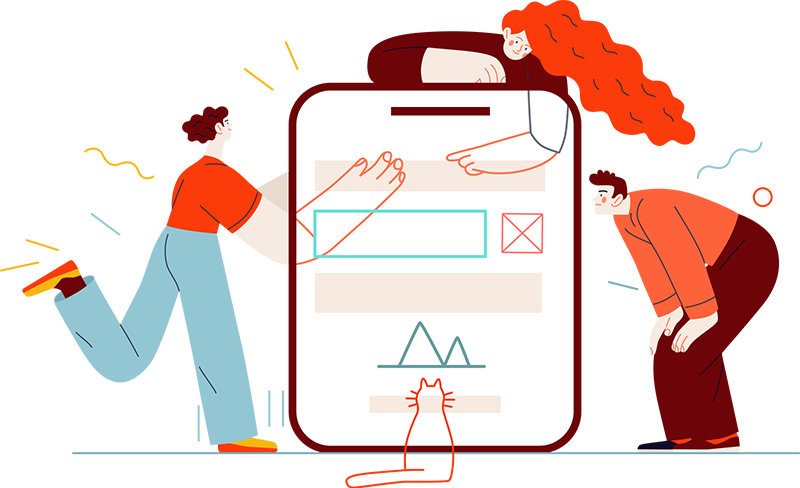
In thinking about how your website can help you work smarter not harder, let’s first answer the question: What IS a website? A website is more than just code, pictures, and content. A website is basically your business’s storefront online. If someone walked into your shop in real life (even if you don’t have a physical location), what would they see (or what would you want them to see?) How would your business convey itself to its customers? What would your customers be looking for? A website is a way to translate that experience onto the web.

Whether you sell products, offer a service, or purely provide information, you have to decide how you want viewers to perceive your business and what conclusions you want them to make. Determine what your website visitors will be looking for, and give it to them immediately. If what they are looking for is hard to find, you will lose them quickly – in about 15 seconds, to be exact.
So, you’ve answered those questions and you have your website all set up and people are visiting your site. Now you may be asking, how can your website help you work smarter, not harder? There are actually many ways your website can work for you that you may not know about. You can use your website to get leads, promote your business, build credibility, get exposure, showcase your brand, support your customers, and automate some of your workflow. That may seem like a lot, so let me break it down for you.
Work smarter not harder: using your website for lead generation.
Adding forms to a website is a simple and effective way to get leads. Add intake or email signup forms to the pages that your visitors navigate to most to increase lead generation (pay attention to analytics data to see where users are spending the most time on your site). Make sure there are clear call to action (CTA) buttons and directions throughout your website that lead users to your form. Once a user lands on the page with a form, don’t ask for too much information or you may deter someone from filling it out. Also, give them a reason to enter their information by offering them something in return – such as a free consultation, email subscription for updates, or some type of download. Extra content or information is a good incentive for people to fill out and submit a form.
Using your website to promote your business and showcase your brand.
Your website gives you a way to show customers who your business is and what you offer without them having to leave home. You can use it to add photos of your work, talk about your services, list and sell products, or add a blog where you can share information. All of these things reflect you and your business and give people a sense of what you do and what they’ll get from doing business with you.
Using your website to build credibility.
A website can also showcase your business history, what your values are, and who your other customers are. Sprinkling in some testimonials throughout your website is a simple way to add some credibility and trustworthiness to your business. Adding information about how long you’ve been in business or how you got started and why is another great way to create a positive perception among your customers. Adding in your values helps customers connect to your business and builds trust.
Using your website to get exposure.
Being available online gives your brand many more chances to gain exposure and to be found, near AND far. You can be discovered by people from multiple locations instead of just one specific location. For example, if you’re a lawyer in Texas, but you have attorneys licensed to practice in NY, you may want to promote yourself there, too. Your website gives you a chance to communicate with those people or prospective clients/customers, whereas in the past that wasn’t possible. Physical stores or shops don’t get the exact same opportunity because often they are only found by proximity to the location where the person is searching or by someone happening by. A website gives you a better chance to be located.
Using your website to support your customers.
When your customers come to your site, they’re usually looking for something, whether they have a question, need a product or service, or are looking for a location. You can support your customers by making the things they’re looking for easily accessible to them. If it’s likely that visitors may have questions, include an FAQ page or a live chat option. Display a phone number or other contact information where it’s easy to see. If you sell products, don’t make a visitor click through two or three pages to finally get to your product inventory. Extra unnecessary steps can be a cause of frustration for website visitors. You want your customers to feel like you understand them and what they’re looking for.
The best way to support your customers with your website is to view it from their perspective. Every step should be thought out and intuitive to the client. The next step should always be there and available when they are ready to move on. If your website experience is disjointed, it’s more likely that you will lose potential customers to frustration, which ends in a lose-lose experience for both parties.
How to work smart with your website: increase efficiency with integration and automation
There are many ways to connect and integrate the tools you use for your business with your website so that everything is in one place and can be automated. You can connect an email opt-in form on your website with your marketing automation platform such as MailChimp or Constant Contact. That way, when someone fills out and submits the form, it automatically adds their information to a list of leads that you can create within the platform you use.
Connecting your email platform to your website allows you to automate actions, like sending welcome or thank you emails or reminding customers if they leave something in their cart. Once set up, these steps can happen without any additional action from you.
There are ways to connect other systems with your website, like product inventory, calendars, events or ticket sales so that you only have to update information once and it updates everywhere. This saves time, money, and manpower – and who wouldn’t want that? Zapier is a great tool that we suggest if you’re looking for ways to connect and automate your apps.
We love finding new ways to make our lives (and our clients’ lives) easier, and we do what we can to work smarter, not harder. If your business or website is in need of some help, reach out to us and we’d be happy to put our brains to work coming up with solutions!